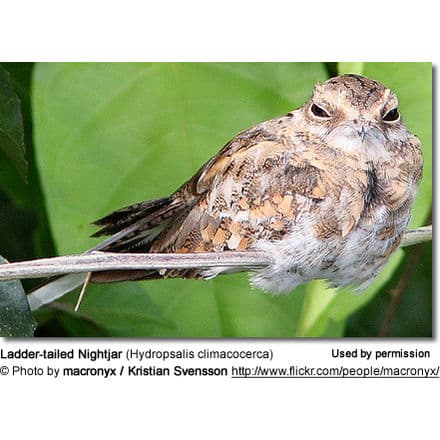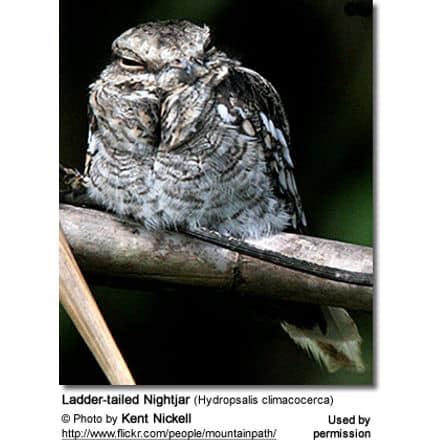Ladder-tailed Nightjars
The Ladder-tailed Nightjars (Hydropsalis climacocerca) – sometimes also referred to as Guiana Goatsuckers – are South American nightjars that occur naturally in all regions of the Amazon Basin and in the Guiana Shield and the Guianan countries. The Scissor-tailed Nightjar is its sister species.
It is a member of the Caprimulgidae family which is sometimes referred to as goatsuckers, as they were often seen in fields together with goats and sheep, and the myth was born that they were there to suck milk from the teats of goats (the Latin word for goat-sucker or goat-milker is Caprimulgus). However, instead, they fed on the insects that were attracted to livestock. In the past, night-flying birds – such as the nightjars – were suspected of witchery.
These nightjars, as suggested by the name, are strictly nocturnal. Throughout the day, they typically rest quietly in densely vegetated hiding places. At night, they become active as they hunt flying insects in more open landscapes, such as forest clearings, wetlands, and along rivers.
Their cryptic appearance allows these birds to blend perfectly into their habitat and they are very difficult to spot during the daytime, when they are usually hidden away sleeping. They are most easily detected at night when light from car headlights is reflected red from their eyes, as they are sitting on tracks or roads. However, their presence is most often made known by their loud calls given at dusk.
Alternate (Global) Names
Chinese: ???? … Czech: Lelek klínoocasý, lelek rezavolímcový … Danish: Stigehale … Dutch: Trapstaartnachtzwaluw … German: Staffelschwanz-Nachtschwalbe … Estonian: lõhissaba-öösorr … Finnish: Pihtipyrstökehrääjä … French: Engoulevent trifide … Italian: Succiacapre codagraduata, Succiacapre scalare … Japanese: mataoyotaka … Norwegian: Gaffelnattravn … Polish: Dziwoletek wid?oogonowy, dziwolotek widloogonowy, dziwolotek wid?oogonowy … Portuguese: Acurana, acuraua, curiango-claro … Russian: ? … Slovak: lelek riecny … Spanish: Chotacabras de Escalera, Dormilón Coludo Blanco, Guardacaminos Rabilargo … Swedish: Stegstjärtnattskärra
Distribution / Range
The Ladder-tailed Nightjars occur naturally in the Amazon Basin of Brazil ranging north to Colombia and Venezuela (the Orinoco River Basin), the Guianas, Guyana, Suriname, and French Guiana, as well as the AmazonianEcuador, Peru, and Bolivia.
They are usually found close to rivers and freshwater lakes in a wide range of habitats. During the daytime, they typically roost on gravel bars or dead trees overhanging a body of water. They mostly live in pairs rather than flocks.
Recognized Subspecies and Ranges
Note: The validity of the subspecies intercedens, pallidior, and canescens is questioned by some authorities as very little information is available about these races, and all three share a very limited common range, between Obidos and Santarém in the lower Amazon region.
- Hydropsalis climacocerca climacocerca (Tschudi, 1844) – Nominate Race
- Range: Southeastern and eastern Colombia to southern Venezuela, and south to north-eastern Bolivia.
- Hydropsalis climacocerca schomburgki (P. L. Sclater, 1866)
- Range: Eastern Venezuela and the Guianas.
- Hydropsalis climacocerca intercedens (Todd, 1937)
- Range: North-central Brazil recorded in the town of Óbidos in western Pará.
- Hydropsalis climacocerca pallidior (Todd, 1937)
- Range: North-central Brazil at Santarém in western Pará.
- Hydropsalis climacocerca canescens (Griscom and Greenway, 1937)
- Range: North-central Brazil, where it only occurs in the lower Tapajós River region in western Pará.

Description
The Ladder-tailed Nightjars measures 9.4 – 10 inches (24 – 26 cm) in length, including its tail.
The male’s plumage is patterned with white, dark, and light greys, and some brown patches – particularly around the neck and head. It has a relatively long, W-shaped tail with white markings and a prominent white patch on the outer flight feathers.
The female’s plumage is duller and the white markings on the male’s wings and tail are replaced with cinnamon.

Nesting / Breeding
The male establishes his territory and sings at night to keep rivals away and at the same time to attract a female.
Ladder-tailed Nightjars don’t actually construct a nest, as most other bird species do. They simply place the eggs on the ground on open soil covered with dead leaves.
Nesting appears to be timed in such a way that the moon is more than half full at the time they are feeding their young – likely as the additional light during the night facilitates caring for the young and foraging for food.
The female may lay one to two eggs (mostly two) that are whitish or creamy in color, with brown and grey spots or blotches.
During the day, the incubation of the eggs is undertaken by the female, while both parents share the incubation at night. The incubation period is about 19 to 21 days to hatching. The young are covered in down and are capable of short-distance movements within 24 hours of hatching. The male usually stands guard and defends the nest and the nestlings. He will hover in place near the nest with his body in a nearly vertical position. The parents communicate with their young via soft clucking sounds to which the chicks respond.
The adults feed the young regurgitated food (insects), and they continue to brood them until fledging. The chicks take their first flight when they are about 20 to 21 days old.
If conditions are favorable, the female may lay a second clutch close to the first and while she is incubating the new set of eggs, the male continues to care for the young from the first brood.
They have developed several behavioral adaptations to minimize predation:
- Their nocturnal (night) lifestyle reduces the likelihood of being detected by daytime predators. During the daytime, they typically sleep on the ground where they are perfectly camouflaged by their “earthy” colored plumage. They almost always change their roost sites on a daily basis.
- When nesting, they sit quietly on the eggs, minimizing any movements that could get them detected.
- If an intruder does get close to the nest, the parents may try to lead them away by first flushing off the nest and when landing feigning injury as they lead the potential thread away from the nest. While the parent performs this distraction display, the young may scatter and freeze.
- The parent who is not incubating the eggs or brooding the young will roost away from the nesting area.
- They may also move the eggs or young to prevent them from being preyed upon.
- Nightjars avoid voicing when they hear the calls made by predatory nocturnal animals, such as owls.



